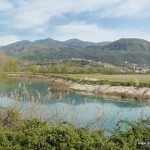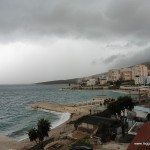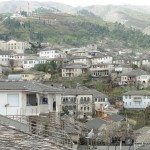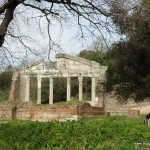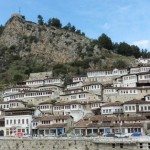Today we travelled from Durrës up to the capital to do a free walking tour of Tirana. The starting point for the Tirana Free Tour is the National History Museum which overlooks Skenderbej Square. We googled Tirana and then zoomed in on the map to discover the Free Walking Tour of Tirana is featured on the map. Gazi, a local guide, met us outside the museum and told us that he guides the tour every day of the year.
On the tour there was a good mix of of people from Sweden, US, France, Germany and of course two Aussies. Gazi was a local who grew up during Albania’s communist period and turbulent transition to democracy so unlike a lot of other tours we’ve been on Gazi had some real street credibility.
After introductions Gazi gave us the condensed history of Tirana and Albania, up until modern times. Like many of its Balkan neighbours Albania was ruled by the Romans, the Byzantines and the Ottomans. With the collapse of the Ottoman Empire in the 20th Century Albania was able to finally be an independent nation, but what sort of nation. For the next two hours Gazi was to guide us through Albania’s modern history as we walked around the city on the Free Walking Tour of Tirana.
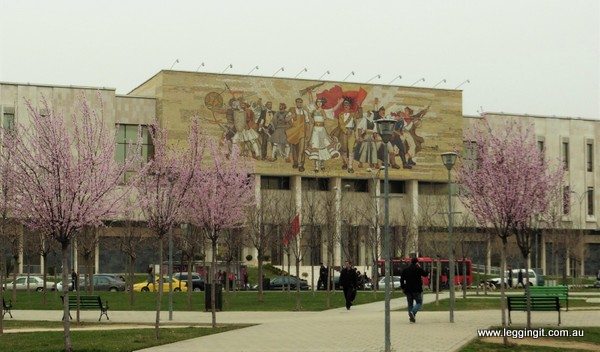
The National History Museum, has a wonderful mosaic which dates from communist times. It is a great example of communist propaganda. On either side are historical figures from Albania and the central figures are very symbolic communist figures. A woman in traditional dress holds a rifle above her head whilst a heavily muscled male worker stands at her side.
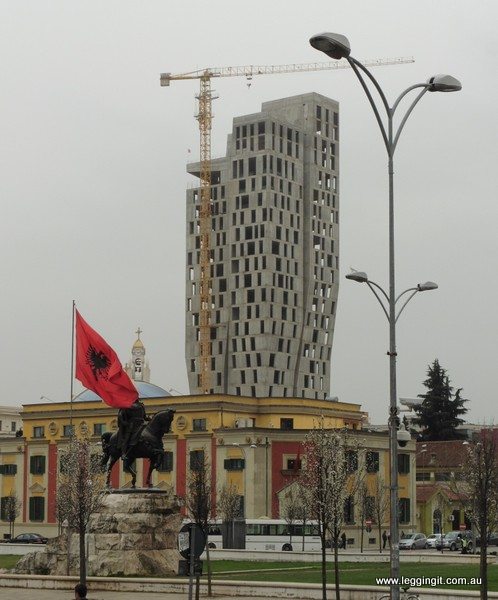
Not far from the National History Museum is a statue of a man on a horse, Skenderbej. We’d first heard his name in Ulcinj, Montenegro when we visited Cruisers restaurant on Australia Day and ordered a Skenderbeg Schnitzel. It’s a rolled schnitzel filled with cheese. In the rest of Montenegro it’s called a Karadjordjev Schnitzel after a Serbian hero. However, as Ulcinj is located on the beach not far from the Albanian Border and its inhabitants are mainly Albanians their schnitzel is named after an Albanian hero. Skenderbej (Skanderbag) liberated parts of Albania from the Ottomans and ruled for 25 years a until his death in 1468. He became famous for defeating superior Ottoman forces. After his death Albania was eventually overrun. The current Albanian flag is based on Skanderbag’s family crest of the black double headed eagle on a red background.
Skanderbeg Square is surrounded by different styles of buildings mostly quite modern. Some are communist era and the others from King Zog I era. There’s no statues of King Zog I, as we learnt he was a despot. He was part of the post First World War government which was established after Albania gained independence from the Ottoman Empire. He became prime minister and then appointed himself King Zog 1 (after changing his name from an Italian sounding name to a more Albanian name). His claim to the monarchy was that he was descended from Skenderbej’s sister. After appointing himself King he started eliminating anyone who spoke out against him.
After the Italian invasion in the late thirties King Zog 1, left Albania for a life in exile. These days apart from buildings which were built during his reign the only mention of him in Tirana is Boulevardi Zogu 1 which runs off Skenderbej Square. The other buildings around the square of course belong to the communist period and like many communist era buildings are designed to give the impression of strength. The communists came to power at the end of WW 2 after fighting the German occupiers. The head of the Communist party was Enver Hoxha who modelled himself on his great mate Stalin. Under the communist system religion was banned so many mosques and churches were pulled down or converted for other uses.
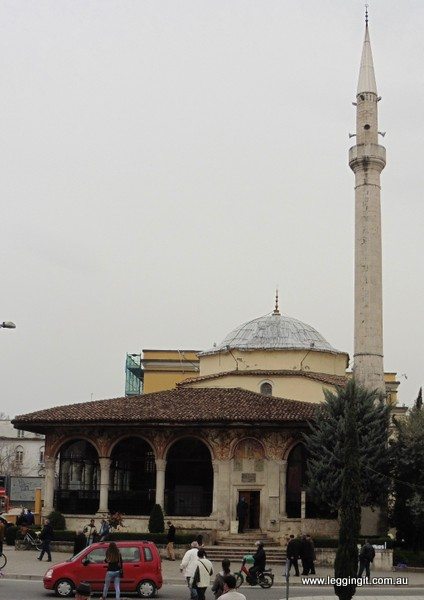
One mosque which escaped demolition was the Et’hem Beut mosque on the edge of Skenderbej Square which was turned into a museum. Since the fall of communism the mosque has converted back, but is also open for visits.
As we wandered through the city streets Gazi told us what it was like to live under the communist rule. He explained how their leader, Envar Hoxha, became a Marxist dictator with a cult following. After falling out with neighbouring communist countries, Albania fell out with USSR and by the 80’s China effectively making it a renegade state without any major trading partners.
Anybody trying to escape was seen as a traitor and shot. It was a place where people tried not to be too smart for that was threatening to the system. During this period dissidents were jailed, executed or sent to work in mines. It was a fascinating insight into how life really was. He also told us how Envar was adored and celebrated much like what we see with Kim Jong Il in North Korea. The paranoia of invasion that the regime instilled in the population was unbelievable, however we had seen evidence of it as we passed through the country. Throughout the country over 70,000 bunkers were installed. In peoples yards, city streets, a mixture of one person and bigger gun emplacements were installed in big defensive rings right across Albania.
In a park nicknamed Checkpoint Charlie there’s a monument to the communist era with a bunker, bracing from a mine and a piece of the Berlin Wall.
It was intriguing to hear Gazi’s stories of growing up in communist Albania. Especially how the population was brainwashed into thinking that despite food rationing they were doing better than every other country. Some of the propaganda art is housed in the National Gallery of Art not far from Skenderbej Square.
It was interesting to hear how current day Albania is tolerant of all religions. There’s even a sect of Muslims who originated in Turkey who eat pork and drink alcohol.
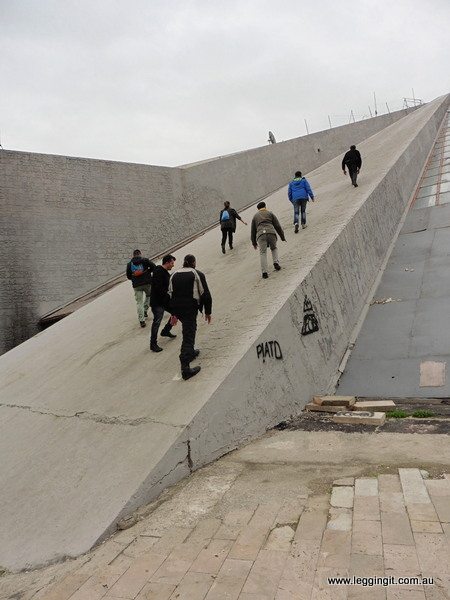
Along the way we visited the Tirana pyramid, which was built by Envar Hoxhas daughter as a tribute to her father. Originally it was going to have an exhibition inside but these days it’s abandoned but teenagers have been climbing it for years. It’s pretty cool to climb and the view for the top is also great.
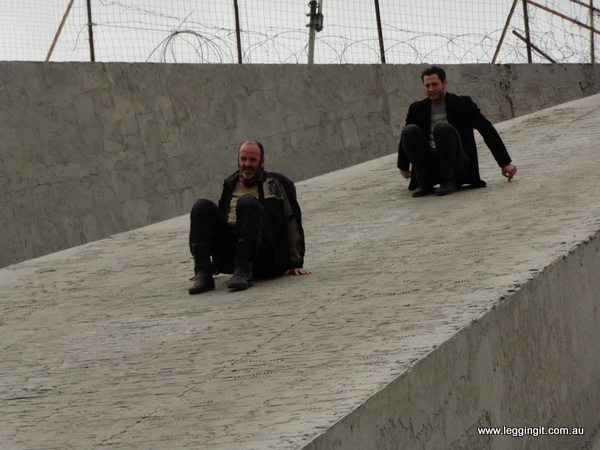
Getting back down is a little challenging but next time I might take a sheet of tin to slide on.
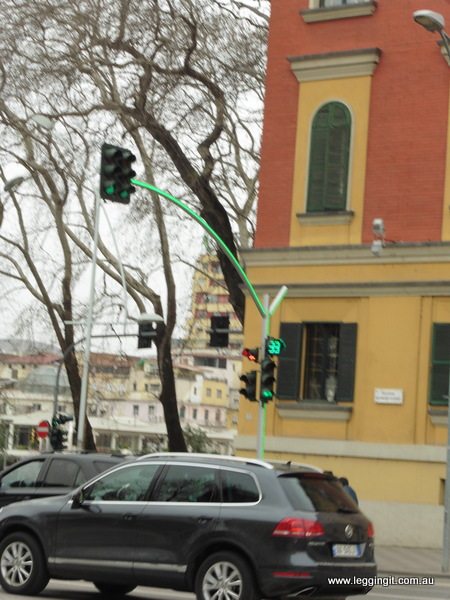
One thing we noticed during the walking tour of Tirana was the futuristic traffic lights. Here in Tirana if you’re stopped for running a traffic light you can’t simply say “the light was yellow officer” because the whole pole lights up.
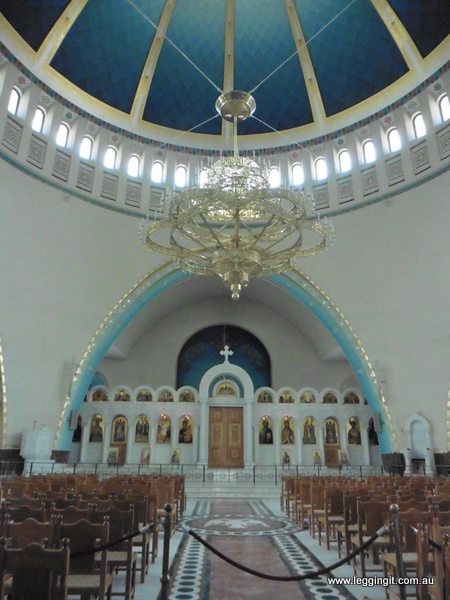
The tour took us to various new mosques and churches including the Resurrection of Christ Orthodox Cathedral, St Peters Catholic Church and the new mosque being built next to government house.
On the tour there were lots more interesting titbits, things to see, stories and things to discuss. Another thing which I found quite endearing was the Albanians sense of humour. In particular their ability to not take themselves too seriously and laugh at themselves. I think we’re going to love exploring more of Albania and getting to meet local people.
As a final comment we’d certainly recommend the Free Walking Tour of Tirana, and would even do another one when we return to Tirana. It was really handy to use the tour for a one day learning experience or to get a general layout of the city for further exploration.


